When a listener is still, it implies that they are focused on the speaker and interested, although in extreme cases it means they are sleeping! Conversely fidgeting is an indication of boredom as the body is given signals to take action and leave the conversation – like the body revving its engine in preparation. Fidgeting is therefore a substitute to walking or running where neither is socially acceptable or the situation warrants otherwise. Being stuck in a lecture is one of them! Repeated checking of a watch or clock is another symptom of a desire to leave. With some forethought, an artificial time constraint gives us an excuse to preempt longer than desire visits which can be made useful when visiting in-laws, an advanced use of body language. Watch checking in this case, helps solidify the nonverbal message.
When boredom really sets in we find repetitive behaviours such as tapping the toes, swinging the feet with one crossed over the other, or drumming the fingers. The body may begin to sag or slouch in a seat, or they may lean against the wall. The head will droop showing fatigue or be supported by the hand. The more support is given to the head the more likely it is that the person is bored. A fully supported head holding the majority of the weight is a tell-tale signal that your listener is bored and that a shift in the conversation is in order. On the flip side, if feet suddenly freeze from a jitter, it indicates an emotional change has occurred and that a person is experiencing threat. This is part of the freeze response where people wish to go under the radar in the face of danger. Freezing, in this way, can happen as a result of being confronted with an embarrassing question or situation, or being the subject of a childhood tale that one is not particularly fond about.
Anytime foot jiggling suddenly turns to foot kicking while seated shows that a person has heard something negative and is a response to discomfort. Jiggling usually depicts nervousness, but kicking on the other hand, is used to fight off unpleasant thoughts. This gesture is subconscious and visceral so is a reliable predictor because under most circumstances people don’t realize that they do it. Foot kicking can therefore tell you what people really think about what sort of questions you are asking them because once posed, they will readily begin to kick if it makes them uncomfortable.




